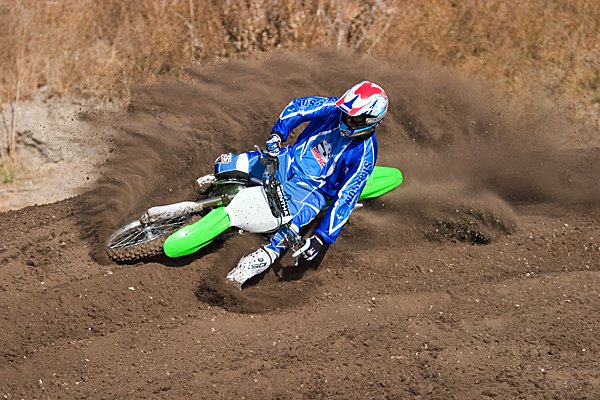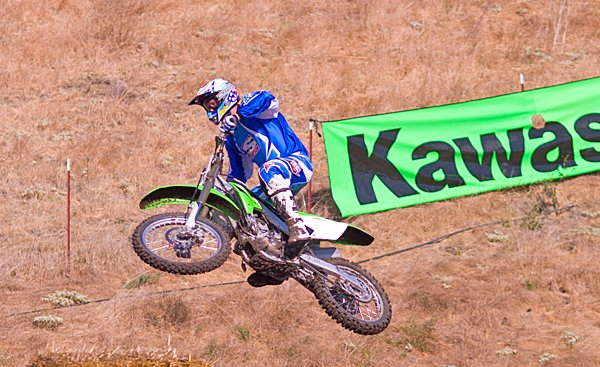2006 Kxf250

Last week, Kawasaki hosted MD and several other journalists at an introduction of the 2006 KX250F motocross bike in Central California at the beautiful Castillo Ranch. The 2006 KX250F is pure Kawasaki — the bike is not shared with Suzuki this year. We gave you all the technical details in our report on June 10, 2005, but it is worth repeating some of the significant changes.
Kawasaki is very proud of the 2006 KX250F. At the intro, a Kawasaki representative stated the KX250F "is the best production motocross bike Kawasaki has ever made." After riding the bike (we will discuss our impressions below), we believe this statement. Kawasaki clearly took the break from Suzuki as an opportunity to throw every technological trick it could at this year's KX250F, and the results are extremely impressive.
Kawasaki pointed out that it has more experience designing and manufacturing perimeter frames for motocross bikes than any other manufacturer. The first perimeter-framed Kawasaki appeared in 1990 . . . more than 15 years ago!
Of course, the 2006 KX250F has an aluminum perimeter frame, rather than one of the steel perimeter frames Kawasaki has become known for. The frame features a combination of castings, forgings and extrusions welded together to form a very strong, but strategically flexing frame. Kawasaki claims it paid close attention to the frame design, and the amount of flex it offers, in order to maximize the handling of the new KX250F.
Another huge change for Kawasaki is the switch to Showa suspension components on the 2006 KX250F. The Showa twin-chamber fork used by Kawasaki has been around for a few years, and has a reputation as the most plush, controlled production fork available. This is apparently the first Kawasaki motocrosser to feature Showa suspension stock.
You might think that a new frame and new suspension would be enough, but Kawasaki tore into the already excellent KX250F motor in search of more power. The stock compression ratio has gone from 12.6:1 to an incredible 13.5:1! The engine also features revised intake and exhaust ports, a new combustion chamber shape, new cams, and revised ignition timing.
Several engine components were beefed up to handle the additional power, including a stronger piston, stronger transmission, stiffer clutch springs and a more rigid, surface-hardened crankshaft. Oil flow to engine parts is increased by nearly 20% as a further guard against mechanical breakdown.
A new radiator is higher in capacity (for cooler running), features more tightly packed cores and is thinner for improved rider ergonomics.
Air box shape and design is critical to making competitive power in the 250F class, and Kawasaki has an all-new air box on the KX250F this year that, according to Kawasaki, results from extensive testing of competing designs. Even the holes in the side panel that allow air flow into the box have been carefully designed and tested to maximize power.

A lighter rear wheel and lighter, wavy brake discs combine with the 2.2 pound lighter aluminum frame to offset additional weight gained with the stronger engine internals. Overall, the KX250F weighs the same as last year's bike.
The 2006 KX250F really is competition ready this year with stock Renthal handlebars and a very trick looking aluminum skid plate standard.
Most of our testing was done by vet pro Russ Somers – now the head of Simpson's motorcycle products division. The Castillo Ranch layout featured thick loam and steep hills — a real challenge for a 250F-class motorcycle. The Kawasaki met that challenge with ease.
Getting to the bottom line, the 2006 KX250F has the most potent motor we have ever tested in this class. At the same time, it has an extremely broad spread of usable power. It is very linear and controllable — but it barks aggressively right off idle, and pulls hard all the way to a strong over-rev. Frankly, the engine performance blew us away.
On this first ride, the rest of the bike was very impressive, as well. The new Showa suspension is extremely well set up. It is plush, controlled, and seems to work for a wide variety of riders (Russ and I are both on the heavy end of the 125-pilot scale!). Although you could occasionally bottom the fork, it had a very good feel with no metal-to-metal clanking. Lighter pilots will probably find the stock spring rates and valving ideal (this bike should work very well for riders in the 150-180 pound range).
The rear wheel stayed hooked-up very well in the thick loam at Castillo Ranch, and contributed to an overall suspension package that was hard to fault. We must note, however, that the Castillo Ranch track lacks the hard, square edges found on many Southern California tracks.
Although the bike is very narrow, and feels light and nimble, it seems to have plenty of room for taller riders (Russ is 6'2″).
The transmission shifted very well under power. The bike jumped well, and the new brakes seemed to offer good feel and excellent power. We had no complaints about the handling — the bike tracked straight and cornered superbly.
What more can we say? Our first impression of the 2006 KX250F is certainly positive. The bike should be available at dealers here in the United States within a week, or so, at a U.S. MSRP of $5,899.

You can follow any responses to this entry through the RSS 2.0 feed. Both comments and pings are currently closed.
Source: https://www.motorcycledaily.com/2005/09/05september05_2006kawasaki_kx250f/







Tidak ada komentar:
Posting Komentar